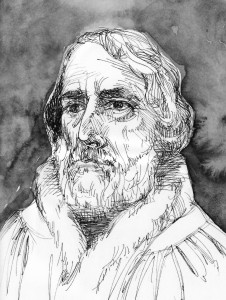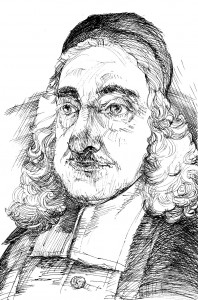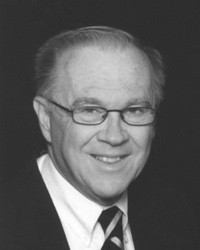The emphasis of the Pietists on the concept of new birth in Christ and the authority of the Bible had startling implications as to how one treated orphans, the lower classes, and one’s opponents. Orthodoxy was not enough. A changed life was required.
It is customary to speak of the material principle and the formal principle of the Protestant Reformation. The material principle answers the question, How are sinful human beings saved or justified before a holy God? The answer: on the basis of Christ’s death alone, made possible by grace atoned and received by distraught sinners by faith alone. This is the content of the gospel, the “material” of Christian life and thought as preached by Luther and Calvin.
The formal principle has to do with authority. On what basis can one know that God is gracious? That he freely wants to have mercy on people? The answer: on the basis of Scripture alone.
Sweeping changes took place in the church following such theological reformations. There was no need for indulgences and purgatory. The teaching authority of the pope was replaced by the authority of Scripture alone. The Mass was shorn of any notion of a redeeming sacrifice. It was now celebrated as a thanksgiving for a redeeming sacrifice completed. The words of institution, “This is my body. . . . This is my blood” were more proclamation than consecration. The list could go on. The material of the faith and the formal character of authority underwent identical changes. They were simplified and made single: one redemption, namely by grace alone; divine authority, namely Scripture alone.
Defining Pietism
The twin principles of the Reformation figured highly in Pietism but not without change and development. The language of salvation changed from its forensic, legal character to a more biological and organic type of expression. No Pietist would deny or disregard the gospel of justification of a sinner by the free grace of God. But a Pietist would express reservation as to the sufficiency of the language of justification to encompass the scope of God’s saving activity.
For one thing, it has a more formal than relational character to it. For another, it is more external than internal as regards its effects on people. It is the formal and external character that Johann Arndt, the “grandfather” of Pietism, came to recognize as a potential threat to the religious life. Arndt had noted that Luther’s preaching of the free grace of God, founded on Jesus’ complete sacrifice for sin and received in faith, had released people from fear. People had feared that their good works were not sufficient or done in the proper spirit, leaving God displeased with them. People also feared long stints in purgatory and the power of the church over them and their eternal destiny.
JOHANN ARNDT
Arndt believed that “every true Christian [should] esteem himself a stranger and pilgrim in this world”—a belief that influenced his book Wahres Christentum, for which he is primarily remembered. This work dwells on the mystical union between Christ and the believer, has been widely translated, and has influenced a range of both Catholic and Protestant theologians. Arndt was influenced by St. Bernard of Clairvaux and Thomas à Kempis.
In Arndt’s True Christianity, he lamented the opposite situation in his day. There was no fear of God at all. The people of the Lutheran lands had been baptized, catechized, and communed. In all of this, the formal and external word of justification had freed them from the bondage of sin. What had happened was that the religious and the personal experiential dimensions of justification by grace through faith were missing. What was missing was awe before a holy God—the God before whom Luther fell down as dead, and at the same time, a profound and mysterious gratitude for a grace that freely reached out to the alienated and to the wicked offering justification before God, self, and others. What Arndt saw as the perversion of justification we would call presumption. When the grace and mercy of a person are taken for granted, they are insulted and made fools of, or so it seems. Bonhoeffer called it “cheap grace.” The Pietists wanted to restore the religious and the personal/experiential dimensions to the relation between God and persons. If this could be done, they reasoned, then a delicate, not a distressing fear would return to religious life. This fear is the fear of presuming on God’s grace or of taking God for granted. If that happens the link between grace and gratitude is severed.
Pietist Reforms
So how did the Pietists speak of the material principle? Shifting from legal to biological language, from an external to an internal work of God, Pietists such as Philipp Jakob Spener (the “father” of Pietism) began to stress the “new birth,” or the work of God within the person, recreating the person from the inside out (John 3:1–15 and 1 Peter 1). Physical birth is a radically passive act. So is spiritual birth. Just as in physical birth, one being born again spiritually neither conceives nor births himself/herself. The chief actor is God. Three stages encompass this work: (1) faith is kindled and issues in new birth, but new birth does not create faith, thus preserving the radical character of God’s initiative; (2) such persons are justified and adopted into God’s family; (3) the “new person” is made complete in the process of sanctification by means of which one’s entire life is brought more and more into the likeness or imitation of Christ.
Among the Lutheran and Reformed Pietists a newer way of formulating God’s work was emerging. God was not only good enough to justify persons, he was also powerful enough to change them. Note the language: “new-maker,” vivification or resurrection power, regeneration, and recreation. August Hermann Francke brought this to a succinct expression in a 1697 sermon on rebirth: “This [i.e., the doctrine of rebirth] is the very ground upon which Christianity stands.” This understanding of the work of God made it possible for Pietists to speak not only of growth in knowledge but also growth in grace. Clearly, the growth language opens the way to speak not only of a progressive sanctification but of a perfecting of the saints. The material principle had now acquired a decidedly human as well as a divine dimension. It now even became customary to raise the issue of the righteousness of Christ being imparted to believers and not just imputed to them. People were not only justified, they were changed.
But what of the formal principle, that of the authority of Scripture among the Pietists? Following the Reformation, formal questions about the nature of the Bible were raised. What gave it its authority? Increasingly, the doctrine of verbal inspiration became the primary way of establishing the Bible’s authority. The words of the authors of Scripture, by the inspiration of the Holy Spirit, coincided with the words of God. What Scripture said, God said. The Scripture then became more closely related to the theological system, serving as proof-texts for statements of doctrine.
During the period of orthodoxy, around 1580, the relation between Scripture and system became even more tightly formed because of the theological conflicts among Protestant groups, each trying to demonstrate that it was the true church. The Scriptures became the instrument of strife as Lutheran and Reformed people each tried to show the more scriptural alignment of their confessions. The Scriptures became more serviceable to polemics than to serving the spiritual needs of the people in the pew.
Hearing and Living the Word
For Pietists, the Word of God was something to be done as well as taught and believed. In addition to lexicons, dictionaries, and commentaries, obedience to the Word was part of the way one brought a text to understanding.
When Francke spoke of the inspiration of Scripture, he took account of the affections and reason, of intuition and intellect. The Holy Spirit “kindled sacred affections” in the writers, making it “absurd to suppose that, in penning the Scriptures, they viewed themselves as machines; or that they wrote without any feelings or perception, what we read with so great a degree of both.” Thus the same Holy Spirit who inspires the affections and reason must also illumine those who read. Why? In order to understand what the apostles wrote, one must not only love what they loved but as they loved. The affections participate in the achievement of clear understanding.
Since one’s affection and intuition lead one on to do the will of God, to experiment with ways to fulfill God’s will, the Pietists spoke of obedience as a way to make God’s Word clear. If in orthodoxy doctrine was tested by Scripture, in Pietism life was tested. The formal authority of the Reformation was brought into direct relation to one’s behavior, thought, and affection. For this reason, it is often said that the Pietists wanted to complete the Reformation. What started as a reformation of doctrine needed to be completed in a reformation life.
Pietist Patterns of Renewal
The material principle gave Spener a clue as to possible ways for renewal. As justification and new birth had served as models for understanding the redemption of persons, a model was needed for the renewal and regeneration of the church. When the Pietists made the “new birth” the operative model for God’s redeeming work, they derived from it the notion of renewal from the inside out. What starts small, develops. Applying this model to the church situation, Spener sought a way to renew the church from the inside out. In his thinking, one could begin in a small way and with a few people and watch the “practice of theology” bear fruit.
PHILIPP JAKOB SPENER
Spener, an educated man, intended to teach but was called to the pastorate instead. Dismayed by the moral ambivalence of his congregation, he wrote Pia Desideria (Pious Desires), a controversial volume marking the birth of Pietism as a renewal movement. He is considered the forerunner of the small group movement.
What emerged was the “conventicle,” a small group of people who met to discuss the Sunday sermon and to make application to their lives. There was an opportunity to discuss Scripture, using the three questions mentioned previously. Naturally, such a gathering was not complete without prayer. This gathering acquired the technical name of ecclesiola in ecclesia, the little church in the big church. What Spener counted on was that this gathering of the reborn ones could engender new life in the entire parish. In this view he differed from the Anabaptists who tended to think that the only true church was the little band of the faithful (the ecclesiola). For Spener, the little church had instrumental value. It was the material principle, the work of redemption, at work in the congregation.
Optimism and Action
What of the formal principle, the principle of authority to embark on such an active pattern of renewal? Spener’s favorite phrase was that God had promised “better times for the church.”
The Pietists believed that the promises were to be acted upon, not just waited upon. God’s promise was organically related to the church and to the church’s obedience to his Word and will. Luther had spoken of faith as a “busy, active, mighty thing.” Together with Luther, the Pietists put Galatians 5:6 into operative terms: “faith that is active in love.” Francke spoke of “risk-taking faith,” not just believing faith. Hence Spener, if ever so modestly, gave faith an operative mode, acting on God’s promise for better times for the church. What were the occasions Spener proposed through which faith could experiment, bringing God’s promise and the human situation into organic relation?
First, greater use should be made of the Bible than just the pericope texts assigned to the Sundays of the Church Year. The conventicle provided an additional setting for increased awareness of the Bible, and provided context, Spener averred, for pastors to have a singular opportunity to learn to know and to be known by parishioners. The setting was ideal. All were under the authority of the same Word of God and under the illumination of the same Holy Spirit. He spoke of this as “bonding.” Take a moment to reflect on the revolutionary character of this proposal in a highly stratified society. No doubt this very setting made possible the change in address to the clergy from “Herr Pastor” to just “Pastor” or the even more familial “brother” and “sister.”
Second, Spener proposed a more extensive use of the spiritual priesthood. By their baptism all Christians had been consecrated kings and priests. What was missing was the exercise of this office. In the conventicle, women and men could speak, a source of no little criticism against Spener. Where this prevailed, baptism, the source of the priesthood of all believers, was given its proper authority. Since all were priests of God, something needed to be done to help people develop their gifts. The Pietists pioneered in vocational education and moved toward classroom instruction in the German language, not Latin. In this way the Pietists sought to help Christians develop their sense of vocation as a calling from God. If all Christians took this seriously, think of how the church’s ministry would be both diversified and multiplied. A preacher-centered church is not a part of the Pietist vision.
Third, it was not enough to have knowledge of the Christian faith, for Christianity consisted in practice. But for Pietists, even practice needed a spiritual dimension. At the orphanage in Halle, childcare workers were called hirelings if their work was merely professionally competent and not personally involved. Such detachment was incapable of engendering new dispositions in the children. When love is tested, the worker does not get testy. Only when love is questioned and one’s commitment tried does steadfast love come through. Steadfast love was what the orphans knew nothing about. So in the wisdom of Spener, Christians were not hirelings but priests, sources of regeneration and hope to a world unfamiliar with God’s grace and love, as Jesus taught in the distinction between hireling and shepherd in John 10.
Spener’s proposals addressed pastoral training and the nature of preaching. What he wanted was a setting for education as much as the content of it. The setting was important because that was where the spirit was either killed or given wings, to cite Gregory of Nazianzus. Spiritual exercises were to be taught as much as content of courses.
The theory was that the preacher required as much preparation as the sermon, because the sermon was directed to the inner person, with the goal in mind to awaken love and fear for God and service to one’s neighbor. The preacher (his demeanor as well as his skill) was to the congregation what the professor was to the theological student. Both school and church were nurseries, places conducive to spiritual growth and vitality. The pastor therefore had two ministries: planter of the seed by preaching and cultivator of the seed by priestly demeanor. And so all Christians have two ministries: planting and cultivating.
Reborn in order to renew. Pietism passed that vocation on to every Christian.
This article was published in Theology, News & Notes, Fall 2009, “Winds of the Spirit: Traditions of Christian Spirituality.”
Prior to Fuller’s publication, this essay was published in full in Christian History 5 (1986): 17–18, 34–35.



